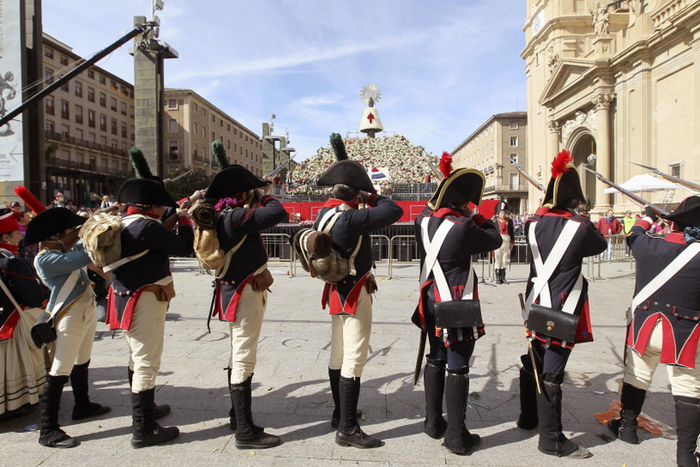12th October floral offering to Nuestra Señora del Pilar in Zaragoza
Zaragoza in the Autonomous Community of Aragón, celebrates its annual fiestas patronales in honour of the Virgen del Pilar

The date of 12th October is an important one for Spain, marked as it is by a national holiday to commemorate the setting foot of Columbus on American soil in 1492, but in the city of Zaragoza, the capital of the region of Aragón, the occasion is doubly special.
This is because 12th October is also the feast day of Nuestra Señora del Pilar, the apparition of the Virgin Mary who is the patron of the city of Zaragoza, of Spain, of the Guardia Civil and the Hispanic World.
To celebrate 12th October in Zaragoza the 3-metre statue of the Virgen, normally housed in the Basilica, is placed on a 7-metre-high structure which is spread below her as a cloak in the Plaza del Pilar in the centre of the city, outside the Basilica and the La Seo cathedral, and thousands of pilgrims take part in a multitudinous floral offering which fills the square with colour and the scent of flowers.
The shawl or mantle worn by the Virgen is decorated with flowers of a certain colour which is decided every year in advance of the celebration, providing a spectacle which thousands turn up merely to witness, and throughout the day people are hard at work “weaving” the mantle. This mantle eventually occupies a pyramid structure which reaches a height of up to 15 metres.

The tradition of the floral offering started in 1958, when the Queen of the Fiestas, Pilar Borrá, placed the first bunch of flowers offered to the Virgen del Pilar. The ceremony began to be considered a tradition only two years later, and by 1964 images of it were occupying the front pages of local and national newspapers alike. That year the Town Hall estimated that there were 8,000 bouquets of a dozen carnations each, and by the following year the bar had been raised to 12,000 bouquets placed by 5,000 people: such was the fervor with which the people of Zaragoza embraced their burgeoning new tradition.
Even older is the traditional offering of fruit, which was first held on 13th October 1949. At that time most of the products making up the offering were from the region of Aragón, but over time the custom has become more widespread, and is now popular all over Spain and even in Latin America.
Nowadays the Virgen is the recipient of such gifts as cheese, cold meats, bananas from the Canaries and oranges from Valencia. People from each region of Spain bring representative products, and even the widely esteemed asparagus stalks of Navarra are among the fruit and vegetables offered up to the patron saint. All the food given to the Virgen is distributed to the needy after the event, and, as is the norm in Spain, the offerings are accompanied by music, dance and colourful celebrations.
In recent years there has been an opportunity for visitors to Zaragoza in the week following 12th October to climb a staircase inside the structure of the cloak for a spectacular photo opportunity.
Images: Copyright Efe





























